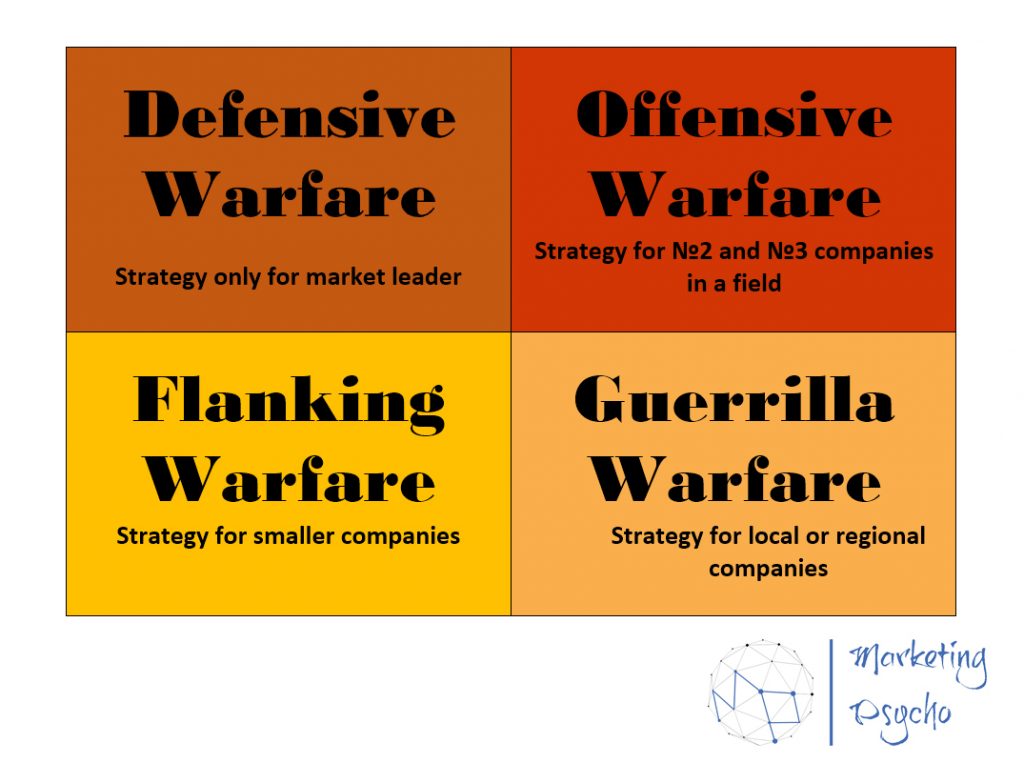Al Ries and Jack Trout dedicated their book Marketing Warfare to Carl von Clausewitz, a Prussian military commander, and military theorist. In their opinion, he is one of the greatest marketing strategists, since the military principles outlined in his book On War are also suitable for the world of marketing. The authors adapted these principles for marketing and described them using the example of large corporations.
Al Ries and Jack Trout believe that the most important thing in marketing is not the buyer, but the competitor. They recommend that you first study the competitor in detail, and then defeat him with the right marketing strategy. In this respect, marketing is similar to war. Marketing warfare is an attempt to use military thinking in solving marketing problems. To do this, marketers must learn from the examples of the greatest military battles and know the basic military principles.
Basic Principles
The first principle according to Carl von Clausewitz is the principle of force. It lies in the fact that in most cases, the big forces always win. This also applies to marketing. Big companies prevail over small ones. A large company can afford large expenses.
The second principle according to Carl von Clausewitz is the superiority of the defense. It lies in the fact that a strong defensive position is very difficult to overcome. No commander wants to attack an army that has chosen defensive tactics. The biggest mistake that marketers make is underestimating the strength of a defensive position.
Al Ries and Jack Trout also suggest exploring the marketing strategic square. You can’t fight a marketing war in one way. The authors distinguish four types of marketing strategies. Choosing the right strategy for your company is the most important decision you need to make. This decision depends on your position in the strategic square that can be built for any industry.
The strategic square

Defensive Warfare
Defensive warfare only applies to the market leader. Evaluate your place in the market, so as not to make a mistake with the choice of strategy.
Principles of Defensive Warfare
- Only the market leader should consider playing defense. You need to assess yourself objectively. Many companies consider themselves leaders. But in reality, this is not the case. The buyer decides who is the true leader. It is the company that first pops up in the minds of consumers and which is associated with its product category that is considered the leader in its industry. You can deceive your competitor, but in no case do not deceive yourself. Look objectively at the situation.
- The best defensive strategy is the courage to attack yourself. The leader should not wait for the competitors to attack him. He must always keep his finger on the pulse. To do this, it needs to attack itself by releasing its products or services with improved features. If the leader does not take any steps, a new player will definitely come sooner or later, who will try to win back market share. Attacking yourself may not bring quick profits, but doing so will win you over in the long run.
- Strong competitive moves should always be blocked. If, after all, the leader missed the moment and the competitor attacked him with a new product, then there is still room for move. We must act quickly. The authors advise in this case to copy the steps of the competitor, until he had time to consolidate his position.
Offensive Warfare
In an offensive war, companies are strong enough to conduct sustained attacks on the leader.
Principles of Offensive Warfare
- The main consideration is the strength of the leader’s position. №2 and №3 companies should monitor all the actions of the leader. The main thing here is not to make a mistake and not to start tracking your achievements and results. Because in this case, you shift the perspective and start acting as if you are a leader, and such a course of thought, based on the experience of other companies, will not bring you success. The leader has a position in the minds of buyers, so long as you do not change these positions, you will not be able to win the fight. Only after the positions of the leader crack, you can try to replace them with your own.
- Find a weakness in the leader’s strength and attack at that point. It is in the strength of the leader that we should look for the weak spot, not where he is weak. If you focus your efforts on the weaknesses in the leader’s position, it will most likely not work, since the leader has enough funds and resources to cover these gaps. But if you can find the bottlenecks in the leader’s power and use them to your advantage, then you will have a chance to achieve the desired result.
- Launch the attack on as narrow a front as possible. To wage offensive war, you need to focus on one thing. Choose the most promising product or service and attack. Don’t waste your efforts. If you attack in several directions at once, you will lose your advantage, as you will have to be distracted, you will spend more resources and time.

Flanking Warfare
Flanking warfare in marketing is a bold and risky operation. A big game with big stakes. A game that requires careful planning of actions by the hour and by the day.
Principles of Flanking Warfare
- A good flanking move must be made into an uncontested area. In this type of war, it is not necessary to create a new product or service, but you must offer the market something exclusive in the existing product or service. You have to stand out. The buyer must consider it a new product category. This approach in marketing is called segmentation. To make a real flanking attack, you need to be the first to take the segment.
- Tactical surprise ought to be an important element of the plan. The element of suddenness is very important when conducting a flanking attack. This is your advantage. Often marketers forget about this. To insure themselves, they start conducting market research and testing, thereby losing valuable time. Competitors do not slumber, they are always on the alert. If they find out about your plans, then you will lose your advantage.
- The pursuit is just as critical as the attack itself. If your product has become a success, then you need to consolidate this success. Don’t stop. Companies often make mistakes and continue to devote time and resources to products that do not make a profit. Leave them, focus on the profitable product. The best time to build a strong position is at the very beginning when the product is new and the competitors have not yet figured out how to act.
Al Ries and Jack Trout suggest in Marketing Warfare book to use the following moves when conducting flanking warfare:
- flanking with low price
- flanking with high price
- flanking with small size
- flanking with large size
- flanking with distribution
- flanking with product form
- flanking with fewer calories
Guerrilla Warfare
The key to a marketing war is to adapt your tactics to your competitors, not to your own company. With the help of guerrilla warfare, small companies have a chance to thrive in a world of huge corporations. The guerrilla reduces the battlefield to achieve superiority in strength.
Principles of Guerrilla Warfare
- Find a segment of the market small enough to defend. Classic guerrilla strategy: focus on a niche or market segment that you can protect from the industry leader. A segment may be small geographically, in terms of sales, or in any other way, as long as it is difficult for a larger company to attack it. The difference between flanking warfare and guerrilla warfare is that a flanking attack is conducted near the leader’s position to take away a part of the market from him. It is typical of guerrilla warfare to find such a small segment to become a leader on it.
- No matter how successful you become, never act like the leader. Leaders often become clumsy because of their large size. To make a meaningful decision, you need a lot of coordination and passage of different levels of obstacles. The too complex organizational structure does not allow them to be mobile. The guerrillas must remember this and take advantage of it. They should not create the same structure, their staff should always be at the center of events to be able to respond quickly to market changes.
- Be prepared to bug out at a moment’s notice. Don’t be afraid to lose the war. It happens. In this case, you need to take the right actions to return. The guerrilla has no extra resources to spend on a deliberately losing plan. The partisan must be able to use his flexibility and jump to a new market quickly if there is an attractive opportunity.
Al Ries and Jack Trout list the following types of guerrilla warfare:
- Geographic guerrillas
- Demographic guerrillas
- Industry guerrillas
- Product guerrillas
- High-End guerrillas
The authors show the application of these strategies by the example of the war between Coca-Cola and Pepsi-Cola, the beer wars involving Budweiser, Heineken, Lowenbrau, and others, the burger war between McDonald’s and Burger King, as well as the computer wars involving Sperry Rand, DEC and others against IBM.
An important role in the conduct of marketing wars is played by the Marketing General. Al Ries and Jack Trout list the main characteristics that a marketing general should have: flexibility, mental courage, boldness, also he should know the facts and rules of the games and be lucky.
The parallel drawn by the authors between the real and marketing wars are obvious. They prove their theory with the help of many examples given in Marketing Warfare book. For your business, first of all, you need to determine your place in the market relative to your competitors, understand who you are, and then choose the right strategy. And remember that in marketing warfare, the main thing is not what you want to do, but what your competitor will allow you to do.
A good addition to Marketing Warfare book will be the other works by Al Ries and Jack Trout – 22 Immutable Laws of Marketing, Positioning: The Battle for Your Mind, and Power of Simplicity.
Read more marketing, management and sales Book Reviews in the special section of the website.





